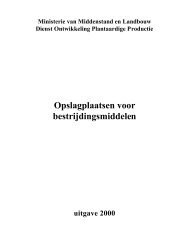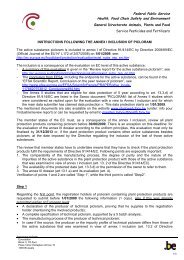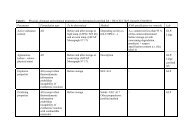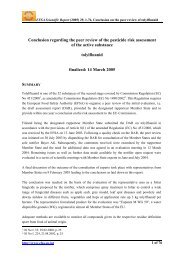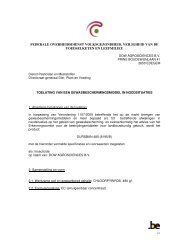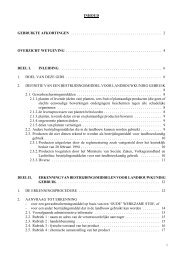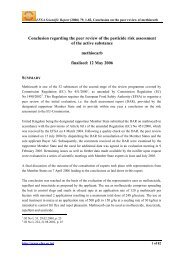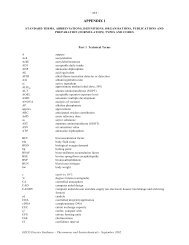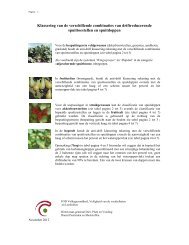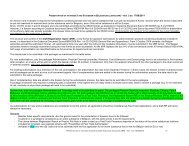Assessment of the Equivalence of Technical Materials - European ...
Assessment of the Equivalence of Technical Materials - European ...
Assessment of the Equivalence of Technical Materials - European ...
- No tags were found...
You also want an ePaper? Increase the reach of your titles
YUMPU automatically turns print PDFs into web optimized ePapers that Google loves.
7.1.2 Evaluation processThe objective <strong>of</strong> <strong>the</strong> evaluation is to identify whe<strong>the</strong>r <strong>the</strong>re is an unacceptable hazard increasefor <strong>the</strong> new source as compared to <strong>the</strong> reference source as a result <strong>of</strong>:• any new impurities or/and• increased levels <strong>of</strong> relevant impurities or/and• increased levels <strong>of</strong> non-relevant impurities which exceed <strong>the</strong> limits mentioned insection 5.2In <strong>the</strong> absence <strong>of</strong> appropriate test data for <strong>the</strong> new source, an unacceptable increase intoxicity, would generally be <strong>the</strong> case if, as a consequence, ei<strong>the</strong>r reference values such asADI, AOEL, or ARfD had to be lowered or a more severe hazard classification resulted. Ifappropriate data for <strong>the</strong> new source are available, <strong>the</strong> guidance at 6.1.3 should be followed.If new or increased levels <strong>of</strong> impurities are present, <strong>the</strong> applicant must provide a case and/ordata to show that <strong>the</strong> new source is not significantly more toxic than <strong>the</strong> reference source. If<strong>the</strong>re is evidence that a new or increased level <strong>of</strong> an impurity will NOT have a significantadverse effect on <strong>the</strong> toxicity <strong>of</strong> <strong>the</strong> new source compared with <strong>the</strong> reference source, <strong>the</strong> newsource is equivalent to <strong>the</strong> reference source. However, if <strong>the</strong>re is evidence that a new orincreased level <strong>of</strong> an impurity will have a significant adverse effect on <strong>the</strong> toxicity <strong>of</strong> <strong>the</strong> newsource compared with <strong>the</strong> reference source; <strong>the</strong> new source is not equivalent to <strong>the</strong> referencesource.The upper limits specified for relevant impurities <strong>of</strong> toxicological concern in <strong>the</strong> referencesource should not be exceeded. However, if this should be proposed, <strong>the</strong> applicant will needto provide a very strong case to support a) raising <strong>the</strong> upper limit concentration and b)equivalence to <strong>the</strong> reference source.a) <strong>Assessment</strong> <strong>of</strong> <strong>the</strong> toxicity <strong>of</strong> impuritiesFor <strong>the</strong> assessment <strong>of</strong> <strong>the</strong> toxicity <strong>of</strong> impurities, <strong>the</strong> considerations described below should befollowed. These considerations are also represented in <strong>the</strong> flow chart in Appendix Ib.As a first step toxicologists consider <strong>the</strong> case provided by <strong>the</strong> applicant, any available data for<strong>the</strong> impurity (as a pure substance or present as an impurity - see Appendix II) and whe<strong>the</strong>r <strong>the</strong>impurity is a structure <strong>of</strong> toxicological concern (see Appendix III). Impurities <strong>of</strong> interest(because <strong>the</strong>y are new or present at increased levels) can initially be divided into <strong>the</strong>following categories:Impurities <strong>of</strong> no toxicological concern: compounds for which <strong>the</strong> toxicity is known to be low(certain non-critical inerts, mineral salts, water, etc.). An additional toxicological evaluationwould generally not be required, but <strong>the</strong> applicant has to submit a reasoned case.Impurities <strong>of</strong> known toxicological concern: (see examples in Appendix III, which is notnecessarily exhaustive): if one <strong>of</strong> <strong>the</strong>se impurities is present in <strong>the</strong> new source but not in <strong>the</strong>reference source, very good evidence would be needed to show that it will not result insignificantly increased toxicity compared with <strong>the</strong> reference source. If convincing evidencecannot be provided, <strong>the</strong> new source is regarded as not equivalent to <strong>the</strong> reference source. If animpurity <strong>of</strong> toxicological concern was identified as a relevant impurity in <strong>the</strong> referencesource, fur<strong>the</strong>r assessment has to determine whe<strong>the</strong>r levels in <strong>the</strong> new source are stillacceptable.7



